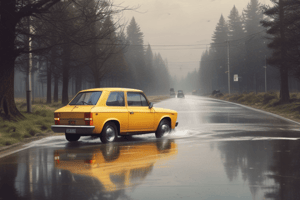Podcast
Questions and Answers
What should you do when visibility is low while driving at junctions?
What should you do when visibility is low while driving at junctions?
- Wind down your window to listen for other vehicles. (correct)
- Increase your speed to clear the junction quickly.
- Avoid using your horn to reduce noise pollution.
- Turn on high beam headlights to improve visibility.
What is a significant factor that contributes to vehicle collisions in bad weather?
What is a significant factor that contributes to vehicle collisions in bad weather?
- Inappropriate driving, not the weather itself. (correct)
- Adverse weather directly causing mechanical failures.
- Visibility being reduced due to road signs.
- Remnants of previous weather conditions.
Why can bridge surfaces be particularly dangerous during cold weather?
Why can bridge surfaces be particularly dangerous during cold weather?
- Bridges are heavily trafficked, causing wear and tear.
- They are not regularly maintained.
- They tend to remain frozen while surrounding roads do not. (correct)
- They are typically made of weaker materials.
What should you consider before making a journey in extreme weather conditions?
What should you consider before making a journey in extreme weather conditions?
When driving in fog, what is a critical action to take regarding speed?
When driving in fog, what is a critical action to take regarding speed?
What is a precautionary measure to take when experiencing aquaplaning?
What is a precautionary measure to take when experiencing aquaplaning?
How can microclimates affect driving conditions?
How can microclimates affect driving conditions?
What should you do to assess your stopping distance in reduced visibility conditions?
What should you do to assess your stopping distance in reduced visibility conditions?
What effect does a film of moisture, grease, or dirt on windows have while driving?
What effect does a film of moisture, grease, or dirt on windows have while driving?
What action should a driver take if dazzled by oncoming headlights?
What action should a driver take if dazzled by oncoming headlights?
When should you use dipped headlights?
When should you use dipped headlights?
What should you check to ensure safety while driving?
What should you check to ensure safety while driving?
What location should you focus on when your vision is impaired by glare?
What location should you focus on when your vision is impaired by glare?
In what situation are reflective studs and markings especially useful?
In what situation are reflective studs and markings especially useful?
What should you do if you are dazzled and need to see the road clearly again?
What should you do if you are dazzled and need to see the road clearly again?
What should you ensure regarding your lights before driving?
What should you ensure regarding your lights before driving?
What should drivers avoid doing when driving on a road surface with a buildup of tyre dust, especially after rain?
What should drivers avoid doing when driving on a road surface with a buildup of tyre dust, especially after rain?
How should drivers adjust their mirrors when the sun causes significant glare?
How should drivers adjust their mirrors when the sun causes significant glare?
What is a key factor when merging with other traffic on a multi-lane carriageway?
What is a key factor when merging with other traffic on a multi-lane carriageway?
What is the primary danger when encountering matrix signs and signals indicating lane closures?
What is the primary danger when encountering matrix signs and signals indicating lane closures?
Which of the following situations is NOT considered an additional hazard on a multi-lane carriageway?
Which of the following situations is NOT considered an additional hazard on a multi-lane carriageway?
What should drivers do when faced with bright sun dazzle while driving?
What should drivers do when faced with bright sun dazzle while driving?
During roadworks, what should drivers particularly remember about the mandatory speed limits?
During roadworks, what should drivers particularly remember about the mandatory speed limits?
What is the risk associated with debris fallen from vehicles on the road?
What is the risk associated with debris fallen from vehicles on the road?
Flashcards are hidden until you start studying
Study Notes
Road Surface Hazards
- Tyre dust and other debris build up on the road surface during dry spells and can make the surface slippery, especially during and after rain. Avoid hard braking, steering, or accelerating during these conditions, as you could lose tyre grip.
Sun Glare
- Bright sunlight, especially low in the sky, can cause serious dazzle, particularly on east-west roads. Use your visors to reduce glare.
- If the sun is shining in your mirrors, adjust them for optimal visibility with minimal glare.
- Remember that other drivers may also be dazzled by bright sun, so account for this when overtaking.
Debris
- Regularly scan the road surface for debris that may have fallen from vehicles. It could damage tyres and cause vehicles to suddenly change position.
Lane Closures and Roadworks
- Roadworks are common on motorways.
- Contraflow systems are not dangerous in themselves but can be risky when drivers don't heed advance warnings.
- All roadworks are clearly signposted.
- Maintain the mandatory speed limits through roadworks, even if conditions seem suitable for higher speeds.
- Merge with other traffic with caution and allow a reasonable following gap.
- Never close your distance to other vehicles while merging.
- Matrix signs and signals indicate lane closures and other changes in driving conditions.
- Pay attention to these signs even if you don't immediately see the need to slow down or change lanes; the incident might be further down the motorway.
Additional Hazards on Multi-Lane Carriageways
- These hazards include:
- Slow-moving traffic
- Traffic lights
- Roundabouts
- Right-hand junctions
- Crossroads
- Traffic moving into the right-hand lane to turn right
- Traffic entering the carriageway from the central reservation
- Traffic crossing the carriageway
- Pedestrians crossing the carriageway
- Entrances and exits other than road junctions (to services, petrol stations, restaurants, pubs)
- Left-hand junctions with only a short (or no) slip road
- Public footpath crossing the carriageway, indicated by an overlap in the central reservation safety barrier.
Overtaking
- It's crucial to be vigilant and overtake only when it's safe to do so.
- It's rarely safe to overtake on a two-way road.
- At junctions with low visibility, lower your window, listen for other vehicles, and consider using your horn.
Weather Conditions
- Bad weather often isn't the root cause of collisions; inappropriate driving is.
- Careful observation, anticipation, correct speed, and adequate braking distances are crucial for safe driving in challenging weather.
- Be mindful of microclimates, as they can cause frost and wet patches to persist in certain areas even after they've disappeared elsewhere.
- Ice can linger in valleys, shaded hillsides, areas shaded by trees or buildings, and result in sudden loss of traction.
- Bridge surfaces are often colder than surrounding roads as they are exposed on all sides and can be icy when the approach roads are not.
- In extreme weather, ask yourself if your journey is absolutely necessary.
- Fog is extremely dangerous; reduce speed and frequently check your actual speed on the speedometer.
- Always be able to stop within your visible distance.
- Follow Highway Code advice for driving in fog.
Lights
-
Even the slightest moisture, grease, or dirt on windows or mirrors can affect visibility and increase glare.
-
Check your headlights are aligned and adjusted correctly for the vehicle load; ensure all bulbs work and the switching systems function properly.
-
Verify your windscreen washers, wipers, and demisters are operational.
Dazzle
-
Headlights shining directly into your eyes can cause dazzle.
-
This can occur on sharp right-hand bends, when oncoming vehicles' lights are undipped or improperly adjusted.
-
To avoid dazzle, look towards the nearside edge of the road.
-
This allows you to maintain your road position, but reduce your speed.
-
If you're dazzled, slow down or stop if necessary until you can see properly again.
-
Use dipped headlights:
- In built-up areas with street lights
- In situations where dipped headlights are more effective than the main beam, e.g., around bends.
-
On unlit roads, use main beam headlights and only dip them for other road users.
Reflective Studs and Markings
- Retlective studs and markings help determine road layout at night.
Studying That Suits You
Use AI to generate personalized quizzes and flashcards to suit your learning preferences.



